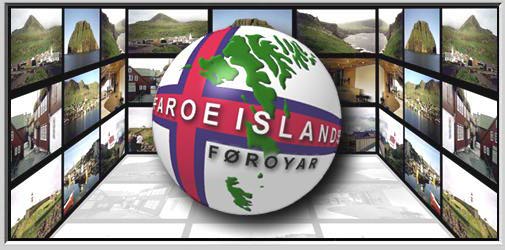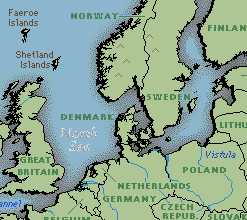

Information about
The Faroe Islands


![]()
Faroe Islands (Danish Færøerne or Färøerne), island group, an integral part of Denmark, in the North Atlantic Ocean, about midway between the Shetland Islands and Iceland. The capital and principal harbour of the islands is Tórshavn (population, 1989 estimate, 14,500) on the south eastern coast of Strømø (Streymoy) Island; it is ice-free. Strømø, Østerø, Suderø, Sandø, Vagø, and Bordø are the most important of the 18 islands, of which 17 are inhabited. The Faeroes were formed by a submarine eruption of basalt during the Tertiary period. A "coal formation" (fiercely, sandstone, shale, and brown coal) makes up the secondary stratum, and this is topped by dolerite. The topography of the islands is characterised by high escarpments and plateau's separated by deep chasms. The peak of Slaettaratindur on østerø Island is 882 m (2894 ft) above sea level. The Faeroes are traversed by a number of fjords and have deeply indented coastlines. The islands, mainly treeless because of continual high winds, have been planted with sturdy conifers, maples, and mountain ash. The principal industries are fishing, sheep raising, and cloth manufacturing. The chief products, mainly for export, are fresh, frozen, filleted, and salted fish; gelatin made from air bladders of fish; sheep, lambskins, and woollen goods; and puffin and eider-duck feathers. About 2% of the soil are cultivated. The Faeroes were part of Norway until the latter part of the 14th century, after which they were held jointly with Denmark, which became sole owner in 1814. The inhabitants are of Scandinavian descent and still speak a modified form of the old Norse called Faroese. The islands passed under the military control of Great Britain in April 1940, during World War II, following the invasion of Denmark by German forces. The British occupation ended in September 1945. In September 1946, as a result of a close plebiscite vote, the Lagting or Løgting (parliament) of the Faeroes declared the islands independent of Denmark. This action was ratified by a Lagting vote of 12 to 11. Suderø, the third largest island, however, announced its continued union with Denmark. The Danish government immediately declared the ballot inconclusive and temporarily dissolved the Lagting. A subsequent poll gave the proponents of continued union with Denmark a slight plurality, and a parliamentary delegation was invited to Copenhagen for further discussion. In 1948 an agreement was reached whereby the Faeroes exercise local autonomy; foreign relations remain under the control of Denmark. The islands send two representatives to the Danish parliament. Area, 1399 sq. km (540 sq. mil); population (1989 estimate) 47,800.
![]()